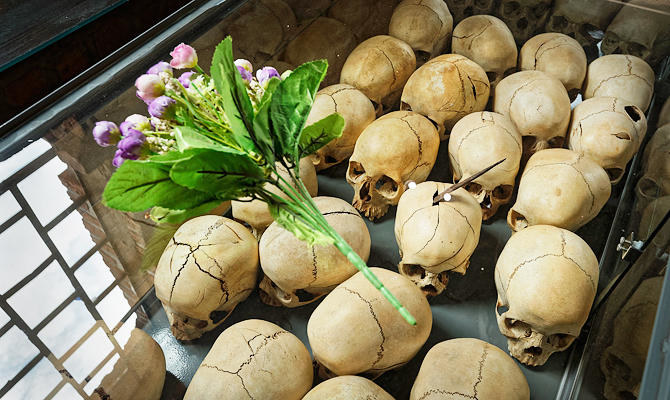KAMONYI, Rwanda: Edith, a 51-year-old housewife, finds it difficult to listen to the radio or watch television in April, the month marking Rwanda’s annual reminder of its 1994 genocide.
Songs and programs broadcast in the east African nation remember the 800,000 people brutally slaughtered over a 100 day period — but also share the pain of those who survived.
“My four brothers and sister were killed during the genocide. This commemoration is important and we must remember them,” Edith — not her real name — told the Thomson Reuters Foundation in her village in Rwanda’s southern Kamonyi district.
“But when I hear the songs or poems on radio, I get flashbacks of hiding in the forest and of how the men from the militia came with their machetes and found me. I remember how they took turns to rape me — and how they impregnated me.”
As Rwanda commemorates 25 years since the genocide ended, thousands of survivors still live in torment, haunted by memories of when extremist Hutus went on the rampage, slaughtering over 800,000 Tutsis and moderate Hutus.
“What they experienced was so totally barbaric that even now we find many are reporting symptoms associated with Post Traumatic Stress Disorder,” said Yvonne Kayiteshonga, Mental Health Division Manager at the Ministry of Health.
“This manifests itself in different ways such as lack of sleep, nightmares, flashbacks, depression or anti-social behavior where they are withdrawn and do not want to be with others. Some survivors also resort to drugs or alcoholism.”
Kayiteshonga said preliminary results of a 2018 national survey found 35 percent of survivors aged between 25 and 65 years reported symptoms linked to mental health problems.
NEIGHBOUR TURNED ON NEIGHBOUR
The genocide began on the night of April 6, 1994, when a plane carrying then Rwandan President Juvenal Habyarimana and his counterpart Cyprien Ntaryamira of Burundi — both Hutus — was shot down.
The attack sparked a rampage by Hutu government soldiers and allied extremist militia with the aim of exterminating the Tutsi minority whom they blamed for killing Habyarimana.
In villages and towns across the densely populated country, neighbor turned on neighbor as people were hacked to death, burned alive, clubbed and shot.
As many as 10,000 people were killed daily. Seventy percent of the Tutsi population was wiped out, and over 10 percent of the total Rwandan population.
Sexual violence was used as a weapon of war with up to 250,000 women and girls raped, resulting in thousands of births.
Hutus extremists also released AIDS patients from hospitals in order to form “rape squads” to infect Tutsi women, and thousands of survivors and their children born from rape are now infected with the HIV/AIDS virus.
The fighting ended in July 1994 when the Rwandan Patriotic Front (RPF), a Tutsi-led rebel movement that swept in from Uganda, marched on Kigali and seized control of the country.
“After the genocide, attention was focused on basic needs such as providing survivors with food, water and housing as they had lost everything — no one paid attention to the trauma,” said Sam Munderere from the Survivors Fund (SURF) which provides counselling to women and their children born from rape.
“And of course, the longer mental health problems are ignored, the more traumatized survivors have become over the years.”
MORE COUNSELLING REQUIRED
Munderere said he met women who had been so violently raped that they felt physically sick when another man approached them.
While other women, who had given birth after being raped, could not accept their children, and mistreated or left them.
In the lush, hilly villages of Kamonyi district, just outside of Rwanda’s capital Kigali, Edith recounted how she withdrew into herself and would stay alone in her room for days after the genocide was over and she discovered she was pregnant.
“I was scared to tell anyone and wanted to have an abortion, or even kill myself, but eventually I confided in a friend and she told me that God had saved me for a reason,” she said.
“Even then, after my daughter was born, it was hard to accept until the people from SURF came and brought me together with other women like me. We had counselling sessions where we just all spoke about experiences and cried and cried.”
Mental health experts said even children born out of rape were in desperate need of counselling as many were unable to accept how they were conceived and felt ashamed of their past.
Edith’s daughter Diane, 24, told the Thomson Reuters Foundation that she struggled when asked about her father.
“When I was growing up I used to wonder about my father, but my mother would not tell me. Now I understand why,” said Diane, not her real name, adding that she used to hate her mother for hiding the truth.
“It was only when I went to a youth camp organized by SURF last year where there were other young people like me that I realized I was not alone. It is important to find people you can trust to talk to or you will become depressed.”
Government officials admitted mental health support was lacking in Rwanda and needed to strengthen for survivors.
They said last year’s survey would help authorities to formulate a policy on improving mental health treatment for survivors, but also much needed to be done to raise awareness as mental health issues still carried social stigma.
“We have trained staff in many health centers across the country to deal with trauma, but we are still lacking counselling services in many places,” said Kayiteshonga.
“We also need to be more aggressive in raising awareness about the issue. There is still a lack of knowledge about PTSD and there is a lot of stigma in the community.”



















